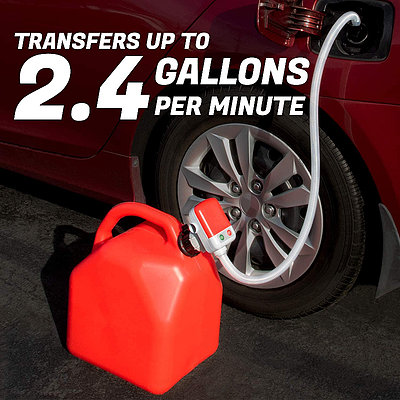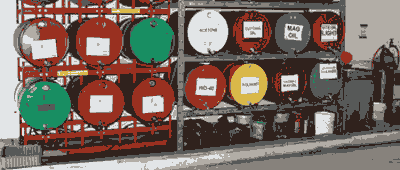The Best Way To Store Fuel
“What is the best way to store fuel, gasoline or kerosene? I was thinking about a 55 gallon drum with a hand pump for access. What do you suggest?” (asked a reader here on the blog)
Gasoline is difficult to store for a long time. It will go stale. Due to EPA regulations, today’s fuels are refined such that they will not last very long in storage (without treatment). Gasoline also has a high vapor pressure (which means it evaporates quickly).
Generally speaking, gas will begin to go stale in a number of weeks (but especially ‘months’) if not chemically treated.
Regardless of how you store fuel, the most important thing for longevity is…
Store Gasoline Treated with Fuel Stabilizer Additive:
Good Gas Stabilizer Additive:
Sta-bil Fuel Stabilizer
(view on amzn)
Best Gasoline Fuel Stabilizer (costs a bit more)
PRI Fuel Stabilizer- For Gasoline 32oz
(view on amzn)
First, some common-sense precautions
- Keep gasoline out of children’s sight and reach.
- Never store gasoline in glass containers
- Never store gasoline in those non-reusable plastic containers (e.g milk jugs).
- Store gasoline in purpose designed ‘gas cans’.
- Never use gasoline inside the home or as a cleaning agent.
- Do not smoke when handling gasoline!!
- Never use gasoline in place of kerosene.
- Only fill portable gasoline containers outdoors.
- Store outside in ventilated shed, etc..
- Don’t use to start a camp fire – too explosive!
[ Read: 3 Gas Siphon – Fuel Transfer Pumps ]
Storing Gasoline in 55 Gallon Drums
55-gallon steel drums can be useful for above-ground storage, vertical with a hand pump or horizontally mounted on a rack with a spigot valve. An advantage to this method is that it’s somewhat portable (compared to underground storage).
If considering a buried tank, set it below the frost line where temperatures are stable at 55° F or so. This will inhibit evaporation. If buried fuel tanks offend your sense of environmental responsibility, then consider above ground storage. Research the laws in your region on this subject.
Store in a shaded place. Sunlight will speed up the oxidation process of the fuel. Temperature swings will cause condensation to form at the bottom (keep a valve at the bottom to periodically drain for this purpose).
Keep the tank near full. This will reduce chances of condensation. You could use a fuel filter at the output valve to separate the water from fuel if this is a concern.
Consult your local regulations regarding underground (and above ground) fuel storage. If one were to decide to bury a 55-gallon steel drum, know that all steel tanks will eventually leak in this condition. If you must store fuel underground, you should use purpose-built underground storage tanks for fuels. Otherwise, be sure to at least coat the tank exterior with many coats of rust inhibitor and/or coat with a thick coat of heavy roofing tar which will help significantly.
Note: “Poly” drums (the type for water storage) are made of high density plastic, and should not be used to store fuel. Over time the fuel will react with the plastic and gradually deteriorate the drum interior.
Underground Storage Tanks For Fuel
Today, the recommended UST (Underground Storage Tanks) for fuel are made of double-wall fiberglass reinforced plastic.
Regarding EPA regulations, do your due-diligence. However, apparently, the following Underground Storage Tanks do NOT need to meet federal requirements for USTs:
- Farm and residential tanks of 1,100 gallons or less capacity holding motor fuel used for noncommercial purposes;
- Tanks storing heating oil used on the premises where it is stored;
- Tanks on or above the floor of underground areas, such as basements or tunnels;
- Septic tanks and systems for collecting storm water and wastewater;
- Flow-through process tanks;
- Tanks of 110 gallons or less capacity; and
- Emergency spill and overfill tanks.
Gas Can Fuel Storage
To directly answer the question of what is the best way to store fuel…
Ordinary gas cans in a shaded outdoor area (or in a ventilated shed or out-building for example).
If you’re talking about quantities like 55-gallon drums, the safest way is underground provided that you are using approved UST’s. I would seriously look at what is available for fiberglass reinforced tanks, although this will cost more than an ordinary steel drum. I do like the notion of portability if stored above ground. Depending on your property, it may be simple enough to discretely hide it.
Be very aware that unlike years ago, today’s fuels are refined such that they will not last long in storage, due to EPA regulations. So you will need to rotate what you have and use fuel stabilizers.
Note: Kerosene is one of the easiest fuels to store, and is more versatile than most people think. It does not evaporate as readily as gasoline and will remain stable in storage with no special treatment. Many pre-1950 farm tractor engines were designed to run on kerosene, and diesels will run on kerosene if necessary.
>> Battery Powered Gas Can Transfer Pump
(view on amzn)

[ Read: Safe Storage of Gas & Combustible Fuels ]

